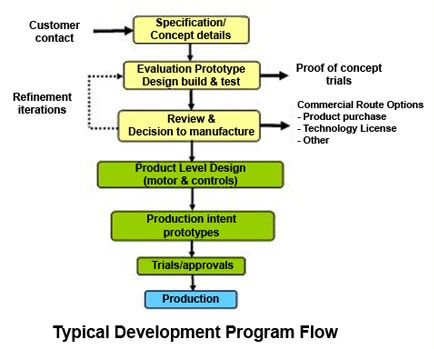SR Drives is a leader in switched reluctance motor and drive technology
Nidec SR Drives Ltd (NSRD) is a leading engineering and technology provider in the field of advanced electrical machines and drives systems, with a particular focus on switched reluctance technology. The company has pioneered the development, application and commercialization of switched reluctance technology under its SR Drive® trademark and is now the world leader in this area.
The company was founded in 1980, having grown out of fundamental research work carried out at two leading UK universities (Leeds and Nottingham). Since then, the company has gained several decades of experience collaborating with customers on new product development to improve their profitability. NSRD undertakes research, development and licensing of their switched reluctance SR Drive technology and other advanced electrical drive techniques across a worldwide spectrum of applications.
Nidec SR Drives Ltd (NSRD) undertakes a wide range of development projects that apply advanced electrical drive technology to customers’ applications. In many cases the applications involve new concepts and NSRD works in close collaboration with the customer to demonstrate in hardware the technical and commercial potential for the development prior to moving forward with product-intent design iterations.
From its inception, NSRD has followed the principle of approaching the design as a system that includes the motor, electronic controls and, in most cases, the application environment in which the final drive will operate. This approach ensures that technical specifications are met and the most appropriate ‘cost to performance’ ratio is maintained. In order to realize this design objective, NSRD has a diverse in-house engineering design, development and testing capability.
Major elements of this capability include:
- Electromagnetic design and modelling for switched reluctance and other electrical machines.
- Power electronic systems design using semiconductor technology appropriate to the power level and supply voltages (12 V to 2500V and powers up to 2 MW).
- Mechanical and thermal design for both motors and their associated power electronics.
- Signal processing system design including hardware & software with technology appropriate for the applications:
- Micro processors and micro controllers
- DSP
- FPGA
- Peripheral electronic system design to support the drive, including power supplies, EMC filtering, communications protocols, etc.
- Full system modelling and dynamic performance prediction, often including the customer’s load characteristics.
- Rapid prototyping and fabrication facilities for motors and controls.
- 4-quadrant dynamometer testing capability up to 350kW.
- Laboratory testing facilities to cover most prototyping requirements.
Note that for unusual requirements that fall outside of the company’s standard capability, NSRD can call upon the extensive resources of its parent company Nidec Corporation.
Although all development programs are usually molded to fit individual customer requirements, the major elements are usually common and a typical development would flow as illustrated below:


